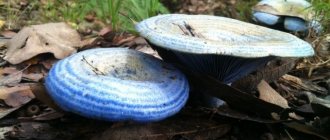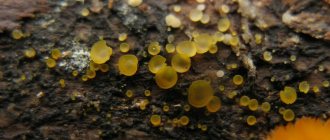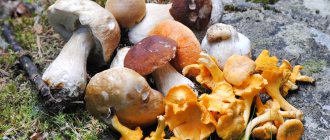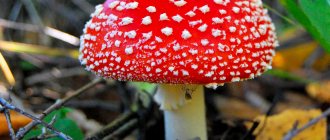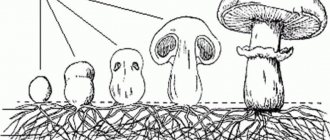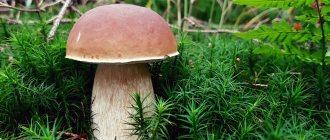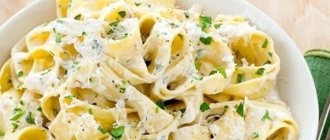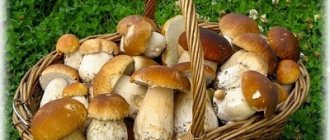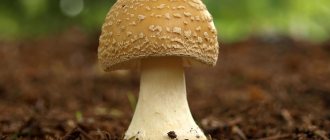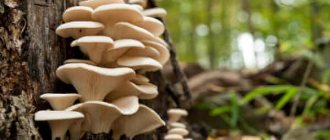Devil's Cigar
Devil's cigar (Chorioactis geaster) is a very rare mushroom that can only be found in Texas and the Japanese islands of Kyushu and Honshu. The fungus usually grows on old stumps and dead roots of trees such as oaks and elms. At the beginning of the growing season, it looks like a dark brown cigar. At the moment of ripening, the upper part of the mushroom opens and a cloud of spores, similar to smoke, emerges from the fruiting body. At the same time, a hissing sound is heard. It is believed that the devil's cigar is the only mushroom that makes sounds. He is often also called the Texas Star.
Bamboo Mushroom (Lady with a Veil)
Bamboo mushroom (Phallus indusiatus) belongs to the Veselkov family and is found in North and South America, Europe, Asia, Africa, and Australia. This mushroom can be recognized by its fluffy lace “skirt”, which is located directly under the cap.
The mushroom has a disgusting smell of rotten meat, and its cap is covered with green-brown mucus containing spores. All this attracts flies, which feed on the fungal spores and spread them. According to some data, the mushroom releases pheromones and, with its special “aroma,” can cause sexual arousal in women - just smell it up close. However, not all representatives of the fair sex can detect these pheromones, but only those who have a well-developed vomeronasal organ.
Despite the smell and unusual appearance, the bamboo mushroom is edible. It is widely used in Chinese cuisine and sold in Asian markets.
Nutritional and chemical composition
Bamboo mushroom has a rich nutritional composition and high pharmaceutical value. Glutamic and aspartic acid are the main flavor elements. Bamboo mushroom contains many vitamins, polyose and microelements. It has been reported that 100 g of dry bamboo mushroom contains 20.2 g crude protein, 0.26 g crude fat, 60.4 g carbohydrates, 1.15 g aspartic acid, 0.69 g threonine, 0.75 g serine, 1 .53 g glutamic acid, 0.3 g proline, 0.72 g glycine, 1.54 g alanine, 2.77 g methionine, 0.60 g isoleucine, 0.83 g leucine, 0.51 g tyrosine, 0. 53 g phenylalanine, 0.45 g lysine, 0.18 g histidine, 0.47 g arginine. The total amount of amino acids is 14.46 g, including the mass of essential amino acids necessary for the human body - 6.88 g. In addition, the mushroom contains many mineral elements, such as phosphorus, iron, calcium, magnesium, zinc, etc. etc. Polyose was extracted from the dried mushroom, the molecular weight of which reaches 144,000 Da. Its composition contains L-fucose, D-xylose (wood sugar), D-mannose, D-glucose in a molar ratio of 0.16:0.24:1.00:1.08.
Aleuria orange
Orange aleuria (Aleuria aurantia) is found throughout the temperate zone: in deciduous and coniferous forests, parks. The mushroom grows on the soil along roadsides, on forest edges and lawns. Fruits from early summer to late autumn. The mushroom cap is bright orange in color and has the shape of a saucer with raised edges.
Orange aleuria is conditionally edible, has a neutral taste and contains vitamins B1, B2, PP, C. The mushroom is recommended to be eaten after heat treatment. You can add it to soups, decorate salads and meat dishes.
Milky blue
Blue milkweed (Lactarius indigo) belongs to the Russula family, found in North and Central America, as well as in Asia. The cap of a young mushroom is convex, and over time it becomes funnel-shaped, with the edges turned down. The pulp has a bright blue color, and after cutting, in air, it begins to turn green.
Blue milkweed is an edible mushroom, but it is only suitable for pickling. These mushrooms must be soaked in salted water to remove the milky juice and get rid of bitterness. Then the mushrooms are boiled and then salted. Dishes made from blue milkweed are popular in Mexico and Guatemala.
Beautiful saprophyte Sarcoscypha scarlet
In early spring, in almost all countries and contingents, entire families of Sarcoscypha scarlet grow on fallen trees. A deeply concave cap is attached to a low whitish stem; its shape is more like a bowl. The inside is bright red, while the outer “walls” have a lighter shade. Some mushroom pickers claim that the pleasant-smelling, elastic pulp of sarcosciphy is quite edible, but most still avoid these mushrooms because they are too small, and also quite tough.
Due to its concave cap and bright color, the mushroom is also called the scarlet elf cup. It is noteworthy that it grows only in ecologically clean areas, avoiding forest belts near large roads and cities, where the air is polluted with all sorts of emissions.
Sea anemone mushroom
The sea anemone mushroom (Aseroe rubra) grows in Australia, Tasmania, New Zealand and several isolated islands in the Pacific Ocean. In appearance, it really resembles a starfish, sea anemone, or some amazing tropical flower.
At the beginning of development, the fruiting body of the fungus looks like a white-gray egg with a diameter of about 30 mm. Then the shell of the fruiting body ruptures, and a stalk with forked red “tentacles” about 40 mm long grows out of it.
The sea mushroom emits an unpleasant smell of rotten meat. This way it attracts flies that carry its spores.
Purple miracle amethyst varnish: photo and description
At the end of summer, in the forests, in damp meadows, amethyst varnish (also known as purple) grows - small mushrooms on a thin stalk with an outstretched cap. The entire mushroom body is painted lilac-violet, even the plates under the cap, which smoothly descend to the stem, the only thing is that in old specimens they fade. The edible tender pulp is also purple, with both a pleasant taste and smell.
The poisonous mushroom pure mycena is extremely similar to old lacquer mushrooms. It can be distinguished only by the characteristic unpleasant smell of radish and the plates of pure white color (in the amethyst varnish they are slightly purple).
Kalocera adhesive
Calocera viscosa is often called the horned plant because of the small “horns” on top. This unusual mushroom seems to glow from within, standing out as a bright yellow spot against the background of the forest floor. It is found in central Russia, Europe and North America, in coniferous and mixed forests.
The fruiting body of the mushroom is 2-8 cm high and has a sticky surface. The pulp is rubbery and gelatinous, with a neutral taste. The mushroom is edible and is considered a delicacy in some European countries. However, in Russia it is not popular due to its low taste, although it can be dried, boiled, fried, and used to decorate dishes.
Kalocera adhesive also has medicinal properties: polysaccharides extracted from the pulp of the mushroom stop the growth of sarcoma.
Common gorsewort
Snapwort (Schizophyllum commune) is a very common tree fungus that is found on every continent except Antarctica. It grows on dead wood in deciduous and coniferous forests.
The slitfoil cap has a beautiful wavy edge that hardens as the mushroom ages. The surface of the fruiting body is slightly pubescent and becomes slippery in wet weather. Color – pale gray with a pink tint.
The mushroom is edible, but in Europe it is rarely eaten due to its toughness. However, it is very popular in the cuisine of many tropical countries, as well as in Mexico.
Trembling brain, or forest brain
The mushroom Tremella encephala belongs to the fairly widespread genus Drozhalka and has a characteristic jelly-like, pinkish colored fruiting body that parasitizes fungi of the species Stereum sanguinolentum. The fruiting bodies of the tremors are gelatinous and matte.
Coloration can vary from pale pink to yellowish-pink. The cross-sectional size does not exceed 30 mm. In appearance, this mushroom is very reminiscent of the human brain; inside it contains a whitish, fairly hard central part. This inedible mushroom is quite widespread in northern temperate latitudes.
Bleeding hedgehog
Bleeding hedgehog , or Hydnellum peckii, is found in the coniferous forests of Europe, North America, Iran and Australia. This mushroom got its name because during active growth its cap secretes a clear red liquid that resembles drops of blood. This attracts insects, which stick to the cap and are then completely absorbed by the fruiting body. Thus, the fungus uses not only minerals from the soil, but also small insects for nutrition.
Young mushrooms produce a lot of droplets, while old mushrooms only have red spots on the surface. On the underside of the cap you can see densely spaced spines. The bleeding hedgehog is inedible, but has good antibacterial properties and contains chemical compounds that can thin the blood. This mushroom has other names: bleeding tooth, devil's tooth, devil's tears.
Pine cone mushroom
Among the mushrooms with interesting shapes, it is worth highlighting the cone mushroom - a very funny mushroom with a cap that looks like a pine cone. It is convex and completely covered with scales, which hang from the edges of the cap, and are also present on the stem. The color is no less interesting: young cone mushrooms are gray-brown, but as they mature, they become chocolate-black. The pulp of this miracle mushroom, oddly enough, is light, but when cut, it first turns red, and then also becomes dark, almost black with a purple tint. Emits a characteristic mushroom smell.
The cone mushroom is classified as a conditionally edible mushroom: you cannot be poisoned by it, but not everyone likes the fibrous pulp.
Crested hedgehog
The comb mushroom (Hericium erinaceus) is often called lion's mane or mushroom noodle. This unusual mushroom grows on trees, stumps and is found in the Amur Region, Khabarovsk Territory, Primorsky Territory, northern China, the foothills of the Caucasus and the Crimea.
The combed hedgehog is an edible and very healthy mushroom. It tastes like shrimp or crab meat. In folk medicine, the mushroom is used to strengthen the immune system, treat chronic gastritis, cancer of the esophagus, stomach, leukemia, and also for recovery after strokes as a stimulator of growth and regeneration of nerve cell processes. Since the mushroom is listed in the Red Book, it is grown artificially, used in cooking in different countries, and also made from it as dietary supplements.
- Note: the medicinal properties of mushrooms – it works!
Did you know that many mushrooms are currently used as medicinal mushrooms?
We pass by some unusual mushrooms because we are not familiar with their properties. However, the world of mushrooms is so interesting that it is undoubtedly worth our attention.
Bibliography
- Guo Yunan, Liu Xiaoling, et al. Nutritional and pharmaceutical properties of the fragrant odorant // Edible mushrooms. 2004, 26(4): 44-45.
- Guo Yunan, Tang Bo et al. Experimental study on the restoration of immunological parameters in white mice with extractive liquid of bamboo mushroom // Chinese medicinal herbs. 2006, 29(2).
- Lin Yuman. Extraction, clarification and characteristics of bamboo fungus poliosis // Bulletin of edible mushrooms. 1995, 2(1): 17-20.
- Xiu Fan. Pharmaceutical value of edible mushrooms // Bulletin of Ningxia Medical Institute. 1990.12(1): 46-48.
- Tan Jingjun. Research on the characterization of the antibacterial properties of the odorous lager // Food Science 2001, 22(9): 73-75.
- Yang Hailong, Liwei. Bamboo fungus poliosis and its effect on human trocytes // Scientific and technical communication. 2000.16(ZD 371-373.
